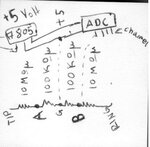plouf
Member level 1

- Joined
- Feb 9, 2012
- Messages
- 39
- Helped
- 1
- Reputation
- 2
- Reaction score
- 4
- Trophy points
- 1,288
- Location
- Athens,Greece
- Activity points
- 1,704
you say amplifying it is making more complicated?
what is your proposal then ?
direct measurement of voltage with ADC?
what is your proposal then ?
direct measurement of voltage with ADC?
Last edited:



